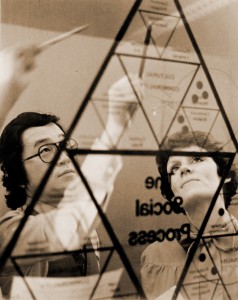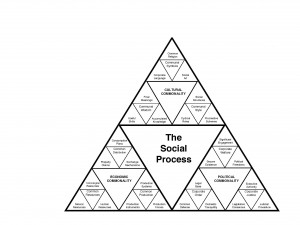Description
Anyone serious about changing society needs to have a “picture” or image of how society operates in order to determine what to do. Whether that be Marx, Jefferson or Hitler, or anyone else, they have a societal model that justifies how they decide to mobilize people and act. They start with an ideology, which informs them as to what is wrong with the current reality and how to act.
The ICA’s Social Process triangles are not related to any ideology, but an attempt to describe how society operates, dynamically, in any society, at any level, at any time in history. They are our attempt to describe the objective reality, without any bias. These triangles are descriptive, not prescriptive. We did use them “prescriptively” when we indicated our interpretations of the imbalances and pressure points and we welcome anyone to use them to deduce their own sense of how society is imbalanced and what pressure points need to be focused upon.
The Social Process Triangle is a graphic catalogue of all the dynamics that constitute a social unit.
In the early 1970s the Ecumenical Institute / Institute of Cultural Affairs focused on a “turn to the world” from its missional emphasis on Church Renewal. The aim was to demonstrate ways for local churches to effectively serve their communities. This required a comprehensive understanding of the social fabric. The Institute, like every social movement that intends modification of society, needed a picture of the society they intend to create.
A two-year research project was initiated (1971-1972) in which colleagues around the country engaged in reading and summarizing hundreds of books related to the dynamics of society. The results were pulled together in research assemblies in Chicago. The products of this research included 1) The Social Process Triangle, 2) The Imbalance Analysis, 3) The Pressure Points, 4) The Whistle Points, and 5) The Corporate Process Triangle. These models have served as guides for the numerous human development projects and educational endeavors of the Institute
The graphic catalogue of society’s dynamics takes the form of an equilateral triangle, divided into a Sierpinski fractal. This visual image provides a memorable way of grasping, not only the dynamics themselves, but also their relationships. Each of the three major corners of the triangle is broken into three which are then subdivided into three and so on down to the 7th level. The resulting model constitutes a complete listing of all the factors that constitute a society – whether it be a social unit as small as a family or as large as a nation at any time in history. The Institute used this model in analyzing local communities and in formulating strategies for their comprehensive and sustainable development.
The Social Process Triangle also played a crucial role in the Institute’s training programs, particularly LENS (Leadership Effectiveness & New Strategies). Participants analyzed the economic, political, and cultural dynamics of society, identifying trends and issues and developing proposed approaches to addressing them.
Today the model has shown itself useful in another field: managing global business. It has become important for firms operating beyond their “home” countries to have some way to understand their “foreign” environments. Inadequate analyses have generated multiple and expensive issues. Efforts made by management specialists tend to be incomplete. Models such as PESTLE and Porter’s Diamond and SWOT identify some of the dimensions of society but lack in comprehensiveness. The SPT with its multiple levels and clear relationships provides leaders with a checklist of items to consider.
A modification of the Social Process Triangle was developed to account for a particular form of society – a corporation – and the result was the Corporate Process Triangle. Further analysis led to the identification of “Pressure Points” and “Whistle Points” – places in the social process that were particularly catalytic for positive change.
References:
Clarence Mann, “Introduction to Social Process Analysis” in Bending History II: Talks of Joseph Wesley Mathews (Tampa: Resurgence Publishing, 2011) pp. 101-127
Clarence Mann, “Managing Country Risk” in Borderless Business: Managing the Far-Flung Enterprise (Westport, Conn.: Praeger Publishing, 2006) pp. 166-192

